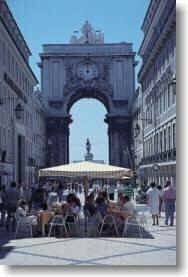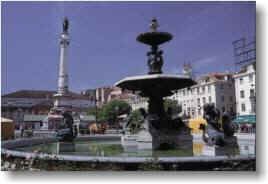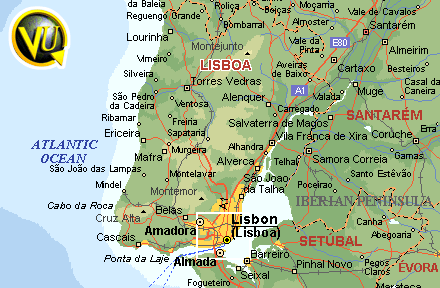
HOME Information Request Form Registration Form Conditions
| Spanish French German Italian Russian Chinese Japanese Greek Portuguese Summer Camps |
||
|
|
PORTUGAL : Lisbon
|
|
||||||||||||||||||||||||||||||||||||||||||||||||||||||||||||||||
| Jan. | Feb. | March | April | May | June |
|---|---|---|---|---|---|
| 5 | 2,16+ | 1,29** | 5 | 3,10+,31* | - |
| July | August | Sept. | Oct. | Nov. | |
| 5* | 2*,23***,30* | 13+,27 | - | 2,15+,29 |
* Starting dates for 30 lessons per week.
** Exclusive starting date for Easter course.
*** Exclusive starting date for summer course.
+ Exclusive starting dates for foreign Portuguese teachers course
School closing Dates
| March | April | May | June | Nov. | Dec. |
|---|---|---|---|---|---|
| 24 | 9 | 1 | 10 | 1 | 1,8,25 |
Available options
Private course on request
Costs
Currency Converter
Prices are in Euros ( € ). Please convert in Canadian dollars when final payment is made. Thank you.
| Program / week | 1 | 2 | 3 | 4 | 12 | 16 | 20 | 24 |
|---|---|---|---|---|---|---|---|---|
| 15 lessons | 276€ | 552€ | 827€ | 965€ | 2275€ | 2964€ | 3570€ | 4178€ |
| 20 lessons | 425€ | 850€ | 1275€ | 1700€ | 4063€ | 5348€ | - | - |
| 30 lessons | 529€ | 1057€ | 1586€ | 1849€ | 5132€ | 6843€ | - | - |
| Teachers course | - | 517€ | - | - | ||||
| Easter or summer courses | 2 weeks: 414€ | |||||||
| Private courses (minimum 2 lessons per day) | 37€ per lesson If 2 students coming together, 28€ per lesson, per student |
|||||||
Our greeting families are recruited with great care. The criteria of selection are very rigorous and each family must satisfy a precise schedule of conditions: excellent morality, desire to communicate with their host, satisfactory social standing. We should specify that the families will only speak with you the language of the country where you will be. It is the principle of the immersion courses !
 The seven hills of Lisbon:
The seven hills of Lisbon:
Some of the highest spots in town:
Monsanto Fort- 230,51 m
Alto da Serafina - 199,23 m
Montes Claros - 170,26 m
Campolide - 141,00 m
Rua da Artilharia 1, building number 102 - 138,09 m
Estrela Church - 137,26 m
Ajuda Palace - 122,93 m
Instituto Superior Técnico - 114,43 m
S. Vicente de Fora Church - 113,30 m
S. Jorge Castle - 112,33 m
Graça Church - 80,00 m
S. Roque Church - 60,00 m
PRAÇA DO COMÉRCIO - CRUZ QUEBRADA
Riverside, West
Praça do Comércio (or Terreiro do Paço) has been described as Lisbon's reception hall and it is certainly one of the finest squares in Europe. The name means "Palace Yard" after the magnificent Royal Palace overlooking the Tagus, which was destroyed in the Great Earthquake of 1755. The open space is about 300 yards square and is bounded on three sides by arcade eighteenth-century buildings specially built to house Government offices, so that Terreiro do Paço is Lisbon's Whitehall. At the northern end there is a Monumental Arch, giving on to the Rua Augusta (Arco Triunfal). This Arch was included in on the original design for the square made immediately after the Earthquake, but the top part was only completed 80 years later and shows marked nineteenth century influence. The architect was Verissimo da Costa and the statues are by Camels and Victor Bastos. But the focal point of the square is the mounted bronze statue of King Joseph I by Machado de Castro which gives it the name of "Black Horse Square" (Estátua Equestre de D. José).
One hundred yards due west of this square is the City Hall (Paços do Concelho) built in 1874. It is worth visiting for its gallery, its main hall and its many art treasures. The ingeniously carved Pillory (Pelourinho) attributed to Eugénio dos Santos in front of the City Hall was erected after the Earthquake. On the south side is the old Marine Arsenal (Arsenal da Marinha) built as part of Pombal's reconstruction scheme. Further west is the Cais do Sodré with its Ferry Quay and the terminus to the Estoril electric railway. A little inland is the Praça Duque da Terceira, a general of the Liberal Wars, whose statue stands in the middle.
Keeping the same westward course we enter Avenida 24 de Julho, Lisbon's great embankment, built at the end of last century. On the south side, running parallel with the Avenue are the docks, warehouses, offices and other installations of the Port of Lisbon Authority, (Porto de Lisboa) stretching to Belém.
Look out, on your right, for the Rocha do Conde de Óbidos. Its stately stairway leads up to the National Museum of Ancient Art (Museu de Arte Antiga - Janelas Verdes) famous for its early Portuguese paintings, including the triptychs by Nuno Gonçalves, the Gil Vicente exhibit and other national treasures. Not too far away, but due east, is the Abrantes Palace (Palácio dos Marqueses de Abrantes), now the French Embassy. Immediately to the north of this is the Madragoa where, by tradition, the fishwives of Lisbon live. Further up the same hill and to the left you come to the Lapa district, rich and residential. Here are most of the foreign Embassies and Legations.
If you take the tram you will very soon reach Alcântara, which is a picturesque though over-populated district. Nearby up the hill to the north is the old royal Palácio das Necessidades, now the Ministry of Foreign Affairs. West of Alcântara, up the Calçada da Tapada is Ajuda Park (Tapada da Ajuda), formerly a Royal Chase. Within this park are the Institute of Agronomy and the Astronomical Observatory.
Returning to the lower route and proceeding westward past Calvário, the next place of interest is Santo Amaro where after a steep flight of steps stands the church dedicated to that Saint (St. Maurus) rich in azulejo (painted tile) panels and borders. Also at Santo Amaro is the main depôt of the Lisbon Tramways on the grounds of the old Conde da Ponte property. Remains of the original palace can still be traced amid the conglomeration of tram sheds and offices.
Junqueira is the road that runs due west, with some fine properties on the land side (Palaces of Conde da Ribeira, Burnay, Ágias, Lázaro Leitão and others). Parallel to Junqueira runs the Avenida da Índia which forms part of the "marginal road" which extends all the way to Estoril.
Belém is the next stop. Here you must really get off your tram or bus for there is a great deal to see.
The Belém National Palace (Palácio Nacional de Belém), a former Royal residence built in the eighteenth century, is now the official home of the President of the Republic. It is here that new Ambassadors or Ministers present their credentials and where official visitors are received. It has a picture gallery and beautiful courts and gardens. Close by is the National Coach Museum (Museu Nacional dos Coches), possibly the finest in the world, with an incredible collection of State Coaches, mainly from the seventeenth and eighteenth centuries.
Up the Calçada da Ajuda past the Colonial and Botanical Gardens (Jardins Colonial e Botânico), past the miniature basilica of Memory where the Marquis of Pombal lies buried, one then reaches the imposing Palácio da Ajuda at the very top of the hill. This, a former Royal residence, is a huge pile begun at the end of the eighteenth century, continued in the nineteenth and never quite finished. It is filled with most delightful early Victorian furniture and fittings. the palace has a very valuable Library (Biblioteca da Ajuda). Not far away stands the solitary Torre do Galo, a tower without a church.
Belém - we are down to sea level again - derives its name from the great church and monastery of the Hieronimyte friars (Mosteiro dos Jerónimos), dedicated to St. Mary of Bethlehem. It is a magnificent specimen of Manueline architecture - a blend of late Gothic and Renaissance, very popular in Portugal in the sixteenth century. The church is unique in the boldness of its vaulted roof supported by decorated columns with spreading tops, and it is richly ornamented with the navigation symbols which characterise the Manueline style. The tombs of Vasco da Gama and Camões, the great national poet, are in the church.
Standing in the river and forming a little peninsula of its own is the Tower of Belém (Torre de Belém), a sixteenth-century erection by Francisco de Arruda, also in the Manueline style. It was built as a fort to guard the entrance to Lisbon and with its balustrades, terraces, statues and balconies is probably the most lavishly decorated fortress in the world.
On to Algés and Dafundo. The bathing beaches begin here. The Vasco da Gama Aquarium is worth visiting for, besides fish, it has an interesting collection of Portuguese fishing craft and nets.
At the very end of this route, at Cruz Quebrada, with a little extra walking, you reach the National Stadium (Estádio Nacional), stone built, scooped out of a side of a hill and sitting 60,000 persons.

Riverside, East
We are back again in "Black Horse Square" for another journey, this time due east. As you proceed along the Rua da Alfândega with the huge pile of the old Custom House on your right, you soon come to the Conceição Velha Church on your left. In reality only the façade, carved in the best Manueline style is old; it was saved form the Misericórdia Church destroyed by the Great Earthquake and was re-erected here. The Casa dos Bicos, a sixteenth century house built by Albuquerque the famous Viceroy of India is in the Rua dos Bacalhoeiros, a little further on, on the same side. It derives its name from the fact that the whole façade is covered with little stone pyramids producing a decidedly prickly effect.
Up the Rua da Padaria, also on the left, is the way to the Sé or Cathedral. This dates from 1147 when Lisbon was taken from the Moors and it is Romanesque in its general lines though with some Gothic additions form the thirteenth and fourteenth centuries. Visitors should see the nave and the King Dinis cloisters, the Bartholomew Joanne's Chapel and the Gothic Ambulatory and Chapels built in the reign of Afonso IV. The Galilee and the outer wall loopholed like a fortress should also be inspected.
Nearby is St. Anthony's Church designed by Mateus Vicente in the eighteenth century. It is like a miniature Italian church in the grand manner. It is the chief shrine of this popular Lisbon saint and is served by a community of Franciscan Friars Minors
Returning to the tramlines and again climbing you come to the Arco Escuro one of the old city gates leading into Alfama perhaps the most tortuous and picturesque of the old wards of Lisbon. Look out for the Jewry Wall (Judiaria), for the Tower of Alfama and other Moorish remains; see the churches of S. Miguel and St. Estevão. The Chafariz de Dentro (or "Fountain within the Walls") is in main square of Alfama. This district stretches as far as St. Vincent. Other ancient gates giving access to Alfama are the Portas do Mar, the Arco de Jesus and the Arco do Rosário.
Back to sea-level and eastward again. The next interesting building is the former Army Arsenal now the Military or Artillery Museum packed with ancient weapons, armour, late mediaeval small arms, old bronze cannon - the whole range of firearms from sixteenth century to our own day; there is on room with the weapons of the first World War and another with those of the Spanish Civil War.
Beyond Santa Apolónia, near the tram lines, is the huge Convent of Santos-o-Novo, now a home for poor gentlewomen. It has the largest cloister in Lisbon and was built in the seventeenth century.
But the finest ecclesiastical building in these parts of the Madre de Deus Church at Xabregas - you pass it in the tram. It was founded as a Poor Clare convent in 1509 by Queen Leonor, wife of John II. The elaborated gilt carvings and the beautiful paintings are the chief attraction but the visitor should also look out for the Manueline cloister and the azulejo panels.
About half a mile from the tram terminus at Poço do Bispo is the Municipal Museum in the Mitra Palace containing a fine collection of Portuguese ceramics and pictures of Lisbon. From its windows one can see the Tagus and busy lines of shipping and lighters. It is fine to walk along the new quays and look over the sparkling river towards on the flying-boat base at Cabo Ruivo which did such good work during the last War.
Poço do Bispo is known for its many factories but you can shake them off if you head northwards and upwards to Marvila, Braço da Prata and Olivais. And from this higher ground the view of the Tagus, at this point many miles wide, is superb.
DOWNTOWN - NEW AVENUES - BENFICA & LUMIAR
North
This time you start from Rossio, officially known as Praça de D.Pedro IV whose statue stands in the middle (curiously, the statue is said to be the one of Maximillian of Mexico - D. Pedro is supposed to be in Mexico...). Of the old Rolling Motion mosaic paving for which this square was famous there are only scant remains around the statue and the two fountains. At the North end is the Teatro Nacional D. Maria II. After São Carlos it is the finest theatre in Lisbon.
Heading north we come first to the Praça dos Restauradores with its obelisk in the centre and the Palácio Foz (built by Fabri in the eighteenth century for the Marquis of Castelo Melhor), where you can find a tourism information post.
The Avenida da Liberdade stretches north to the Pombal Square (Praça Marquês de Pombal) with its monumental statue. In it is the giant greenhouse (Estufa Fria) one of the sights of Lisbon. At Pombal begin the Avenidas Novas (New Avenues), mostly residential and all built in this century.
If you break away from Avenida Fontes Pereira de Melo and follow Avenida António Augusto Aguiar, you soon come to the Palhavã Palace (Palácio Azambuja) now the Spanish Embassy. It was built in the 17th century and is associated with John V who was once lodged there. Along the Benfica Road on the right is Lisbon's fine zoo (Jardim Zoológico) in the never-to-be-forgotten Parque das Laranjeiras. At São Domingos de Benfica (well to the left, off the tram lines) stands the Palace of the Marquis of Fronteira, famous for its gardens with giant equestrian figures in azulejos and fine park. The road to Benfica is bordered with large gardens and houses, some of historical interest. Benfica itself has a fine parish church.
There are splendid modern buildings in Lisbon, as well as old, as you will find if (instead of turning off at António Augusto de Aguiar) you go on to Praça Duque de Saldanha (even the statue in the centre was set up as late as 1909) and along the New Avenue district that contains the Mint (Casa da Moeda), the Technical Institute, the Statistical Institute, the Filipa de Lencastre highschool, all constructed in the twenties/thirties.
The Church of Our Lady of Fátima, off the Avenida da República, is very much in the modern style. The sacred images and paintings are also by modern artists.
A little further north, on the main avenue, is the Bull Ring (Praça de Touros do Campo Pequeno) a huge edifice in the Moorish style, one of the largest in the Peninsula.
In the same open space, on the south side, stands the seventeenth century Palácio das Galveias, which belonged to the ill-fated Távora family, exterminated by Pombal in the eighteenth century. It is now a Municipal Library.
Beyond the Campo Pequeno is the Campo Grande, a long narrow park with a lake with rowing-boats and bicycle track.
To the left of Campo Grande, at no. 245, is the Palace of the Galvões-Mexias - said to have been built by King John V for one of his mistresses. It is one of the finest examples of early eighteenth century architecture in Lisbon and contains the City Museum.
At Lumiar if you turn to the left, you will come to the Palmela Palace (Palácio de São Sebastião) and the Parish Church of St. John the Baptist where the head of St. Bridget of Ireland is kept as a relic.
Lisbon weather
